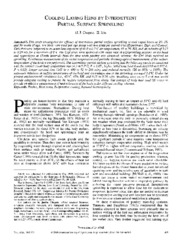| dc.description.abstract | This study investigated the efficacy of intermittent partial surface sprinkling to cool caged layers at 20, 38, and 56 weeks of age. Ten birds were used per age group with two birds per paired trial (Experiment, Expt, and Control, Ctrl) that were subjected to an acute heat exposure of 40.0 ± 0.5°C air temperature, 45 ± 3% RH, and air velocity of 0.15 to 0.20 m/s for a maximum of 8 h. The Expt birds were sprinkled with water mist (8 mL/sprinkling session) on the head and appendages at 15-min intervals from the time when panting was observed; whereas, the Ctrl birds received no sprinkling. Continuous measurement of the rectal temperature and periodic thermographical measurement of the surface temperature of the birds were performed. The intermittent partial surface sprinkling had the following merits as compared with the control: lower body temperature rise (4.3 vs 5.7°C; P < 0.05), higher lethal heat load threshold (10.0 vs 6.6°C-h, P < 0.05), longer survival time (145 to > 480 vs 92 to 266 min), and reduced mortality (20 to 60% vs 100%). The maximum reduction in surface temperature of the head and appendages due to the sprinkling averaged 2.2°C. Under the present environmental conditions (i.e., 40°C, 45% RH, and 0.15 to 0.20 m/s), sprinkling once every 5 to 6 min would provide adequate cooling to prevent the surface temperature from rising. The concept of body heat load ( â) seems to provide an effective measurement of heat tolerance of the birds under different cooling schemes.Author's pre-print on author's personal website, non-commercial pre-print server. | en_US |

